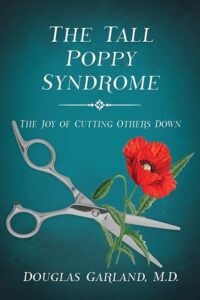Dr. Doug Garland writes this post with some contributions by me. He is an orthopedic surgeon who was one of my mentors during my second year of orthopedic residency. Although I trained in Honolulu, HI, one of my rotations was at Rancho Las Amigos in Downey, Southern California. It is a large county rehabilitation hospital. We took care of the most miserable life situations you could imagine. He was in charge of the head trauma service, and a complication of severe head trauma is developing calcified contractures around your shoulders, elbows, hips, and knees. We wrote a classic paper on the surgical outcomes of resecting this bone. (1)
We reconnected a few years ago and became good friends. He wrote a remarkable book, The Tall Poppy Syndrome: The Joy of Cutting Others Down (TPS), which details its nature and historical background. The syndrome refers to the tendency to be jealous of success and cut others down. It is unfortunately common in the medical world, and he and I have been subjected to it. Personally, his book brought together many disparate events into a cohesive narrative. TPS applies to all walks of life, from your family to society. Aside from the importance of the topic, it is an excellent, concise history book.
We met in his hometown, San Luis Obispo, CA, to focus on bullying, which is a massive issue for me. The downstream effects on a person’s life are horrendous. It was manifested in various forms of chronic mental and physical pain that I saw weekly. Additionally, being unable to protect our young children is unacceptable at every level. It is an extreme form of TPS.
Brian Reynolds, a good friend of Doug’s who hosts a local public radio show, orchestrated these interviews. He is a wonderful host who has developed a strong interest in the nature and effects of TPS. Doug describes “bad envy,” where you are jealous of another’s success, and “good envy,” where you admire it and are inspired to work on your skills. I have “good envy” of Brian’s voice and presentation skills. You will enjoy these shows he put together.

Doug Garland’s blog
Be angry and do not sin; do not let the sun go down on your anger, and give no opportunity to the devil. Ephesians 4:26-27
Anger, Tall Poppy Syndrome, and Schadenfreude (The Luigi Mangione Story)
This is a jam-packed session. I am joined by Dr. David Hanscom, a friend, retired spine surgeon, expert on chronic low back pain, and author of Back in Control: A Surgeon’s Roadmap Out of Chronic Pain, which was found in Mangione’s belongings. I am also including our recent two-part KCBX FM Central Coast Public Radio interview with Brian Reynolds.
UnitedHealthcare(UH)
UnitedHealthcare is a significant health insurance and managed care company, part of UnitedHealth Group, headquartered in Minnetonka, Minnesota. It is one of the largest healthcare companies in the United States and offers various health benefit plans and services.
UH Provides health insurance for individuals, families, employers, Medicare recipients, and Medicaid beneficiaries. Its networks include more than 1.3 million physicians and care professionals and 6,700 hospitals nationwide.
UnitedHealthcare is a significant health insurance and managed care company headquartered in Minnetonka, Minnesota. It is part of UnitedHealth Group and offers various health benefit plans and services.
UH provides health insurance for individuals, families, employers, Medicare recipients, and Medicaid beneficiaries. It works with over 6,700 hospitals nationwide, 1.3 million physicians and care professionals.
UnitedHealthcare’s mission is helping people live healthier lives and ensure a satisfactory health system. It focuses on providing affordable coverage, simplifying the healthcare experience, and delivering access to high-quality care. The company emphasizes diversity, equity, and inclusion and works to improve health equity in communities across America.
It is one of the most profitable healthcare organizations, with an annual revenue of $372 billion and a market capitalization of $474.3 billion.
Brian Thompson
Brian Robert Thompson was born in Jewell, Iowa, on July 10, 1974, into a working-class family. His mother was a hairdresser, and his father worked at a grain storage facility. During his childhood summers, Thompson often worked on farms, removing weeds and engaging in labor.
Thompson excelled academically, graduating as valedictorian from South Hamilton High School in Iowa in 1993. He was actively involved in extracurricular activities, including basketball, golf, and playing the trombone in the marching band and orchestra. He was also crowned homecoming king and served as class president.
After high school, Thompson attended the University of Iowa. He began his professional career as a certified accountant at PricewaterhouseCoopers (PwC), where he worked from 1997 to 2004 as a manager in the transaction advisory services group of the audit practice.
Thompson joined UnitedHealth Group in 2004. His career at the company spanned two decades, during which he held various leadership positions: financial controller for the Employer & Individual division and as a director in corporate development; chief financial officer for the Employer & Individual, Community & State, and Medicare & Retirement business units; CEO of UnitedHealthcare’s government programs, which included Medicare and retirement as well as community and state divisions (2021); and finally CEO of UnitedHealthcare.
As CEO, Thompson oversaw a company that provides health insurance to over 49 million Americans. Under his leadership, UnitedHealthcare’s profits increased from $12 billion in 2021 to $16 billion in 2023. His tenure was marked by significant growth, but he also faced criticism for policies such as automating claim denials and plans to deny payment for non-critical emergency room visits.
Anger
Anger is the second most common negative emotion detected in the cutter in TPS, after bad envy. This type of anger is triggered by adverse events such as provocation, hurt, or threat. Anger commonly occurs when an obstacle blocks one of our objectives.
From my book The Tall Poppy Syndrome – The Joy of Cutting Others Down):
According to some estimates, some philosophers believe anger cannot exist without a desire for retribution, but violence follows only 2–10 percent of anger. Despite this low percentage, the association is part of our psyche, partly due to Hollywood films and media news clips showing things such as rioting and violent crimes. Yet anger is not necessarily a sufficient cause of violence and distinguishes itself from wrath’s more negative tone. When violence does follow anger, TPS is likely in play.

The Tragic Decline of Luigi Mangione: Pain, the Human Survival Response, and Isolation by David Hanscom
Luigi Mangione’s transformation from a promising academic star to an accused murderer encapsulates the interplay of evolutionary instincts, physical struggles, and societal pressures. His story is cautionary, revealing the deeper mechanisms of stress and anger rooted in human survival instincts and their misalignment with modern life.
The Evolutionary Roots of Stress and Anger
Early humans relied on the fight-or-flight response to survive life-threatening dangers like predators or famine. This response prioritizes immediate survival, redirects energy to muscles, and increases awareness, enabling quick reactions. While the threats of the past were physical, modern stressors—missed deadlines, rejection, or failure—trigger the exact survival mechanisms.
The inability of the brain to distinguish between physical and emotional threats leads to misdirected reactions. (2) For Mangione, this manifested in anxiety escalating into anger, an emotion designed to provide temporary control but often misapplied in today’s context. This misalignment between ancient instincts and modern stressors is a central theme in understanding his decline.
Promising Beginnings
Mangione was raised in a prominent Baltimore family known for its philanthropy. His early life reflected immense potential: valedictorian of high school earned both a bachelor’s and a master’s degree in computer science from the University of Pennsylvania in just four years. Creative and driven, he founded a video game programming club and excelled at his first job with TrueCar. However, the isolation of the COVID-19 pandemic disrupted his promising trajectory, sowing the seeds of his unraveling.
The Gradual Descent: Pain, Isolation, and Misdirected Coping
In 2022, Mangione moved to Hawaii, hoping to manage his spinal condition, spondylolisthesis, through lifestyle changes. While initially optimistic, he developed obsessive habits, meticulously planning fitness routines and immersing himself in self-help literature. A surfing accident in 2023 worsened his pain. A stable spondylolisthesis is not considered a source of pain, and surgery is usually ineffective. He had surgery anyway, and it predictably did not provide the relief he sought, deepening his emotional pain and isolation.
Emotional pain, unlike physical pain, can feel inescapable and drive individuals toward destructive coping mechanisms. For Mangione, the obsessive quest to conquer his pain led to the abandonment of support networks and a turn toward “manosphere” ideologies. While these offered temporary relief, they also reinforced his sense of alienation.

The Neurological Impact of Stress and Anger
Stress fundamentally alters brain function, redirecting energy from the prefrontal cortex—the seat of reasoning and decision-making—to survival-oriented brain regions. This explains Mangione’s escalating misdirected coping mechanisms. In such states, anger provides a fleeting sense of power but worsens underlying struggles.
Research into stress and bullying mirrors this dynamic. Bullies often act out of unresolved anxiety, using aggression to regain control, while their victims experience heightened stress responses and long-term emotional damage. This pattern is reflected in Mangione’s obsessive behaviors and isolation, where unresolved stress and pain perpetuated his withdrawal and emotional turmoil.
The Breaking Point: Mangione’s Arrest
By June 2024, Mangione had cut off contact with his social circle. Months later, he was arrested for the predawn shooting of UnitedHealthcare CEO Brian Thompson outside a Manhattan hotel. The crime marked the culmination of his years-long descent into despair. At his arraignment, Mangione appeared disheveled, shouting about injustice—a stark contrast to the composed, ambitious young man he once was.
The Threat Perception Problem
Mangione’s story highlights how the brain misinterprets modern stressors. Unlike other mammals, humans process social and mental threats—such as rejection or failure—through the same pathways as physical threats. Anxiety, the body’s alarm system, becomes overwhelming when solutions seem unattainable, escalating into anger. This survival mechanism, intended to protect, often results in destructive outcomes, as evidenced by Mangione’s case.
The Cycle of Stress and Anger
Mangione’s struggles align with broader patterns of stress-induced behavior. Consider a bullied child: the bully’s aggression stems from anxiety and insecurity, while the victim’s stress mirrors the response to a predator. This dynamic persists into adulthood, shaping relationships and behaviors. Long-term studies on bullying show that victims often face heightened rates of anxiety, depression, and career struggles later in life. (3)
Mangione’s trajectory reflects these findings. His pain and isolation, compounded by unresolved emotional issues, drove him toward coping mechanisms that ultimately failed to address his underlying struggles. His social media activity in his final months reflected a shift toward darker worldviews, signaling increasing frustration and despair.
Tall Poppy Syndrome
Cutter’s anger is driving Mangione’s revenge. In peer-to-peer TPS, anger is often directed at the practitioner who rendered care, especially if gunplay is involved. However, the gun shell casings had the words delay, deny, and defend etched on them (an international indictment against most medical insurers), indicating that his blame was directed towards UH.
Mangione’s manifesto mentions UH by name and notes its increase in subscribers and profit (greed) but not its patients’ longevity. He also mentions corporate corruption. I cannot speak to corruption in US medical companies. Most countries have a governmental one-payer system, which makes them rife with corruption. Indeed, Europe’s medical complex is the most corrupt of all their industries.
Cutters feel justified in destroying greedy TPs or companies. This is second to pride, the number one justification for cutting a company down and the number one cause of company or CEO failure.
Public TPS involves legitimate TPs, often public figures, and requires a village to eliminate them. Mangione could not modify the company, so he chose a scapegoat or surrogate: Brian Thompson. Thompson is a TP CEO who receives a hefty annual wage, another excuse to eliminate him.
Schadenfreude often occurs after TPS. Some were surprised by the amount of schadenfreude generated by this cold murder. Many people have similar impressions and experiences with insurance companies. They are happy to see them suffer some of their own medicine, especially if they have watched a family member die because of denied care. Also, the US has always supported the underdog while recently adding victimhood as well.
Hybristophilia is a paraphilia disorder involving sexual interest in and attraction to those who commit crimes. Paraphilia disorders are increasing, or at least the awareness, due to opportunities made available on the internet.
Milkshake Duck (perhaps Mangione) is a person who becomes extremely popular (viral) on the internet for some “positive” reason. As their popularity grows, their notorious past is discovered, and they become an object of outrage and hatred (TPS). In my book, The Tall Poppy Syndrome: The Joy of Cutting Others Down these types were called weed poppies.
Two things I’ve learned from this event and similar affairs:
- In anger, don’t do something; just stand there.
- When seeking revenge, dig two graves.
Therefore, be imitators of God as beloved children. And walk in love, as Christ loved us and gave himself up for us, a fragrant offering and sacrifice to God.
Ephesians 5: 1-2
A Summary of the 2-part Interview with Doug Garland and David Hanscom
References
-
Garland DE, Hanscom DA, Keenan MA, Smith C, and Moore T. Resection of heterotopic ossification in the adult with head trauma. JBJS – AM (1985); 67:1261-9.
- Eisenberger N. “The neural bases of social pain: Evidence for shared representations with physical pain.” Psychosom Med (2012); 74: 126-135.
- Anda RF, et al. “The enduring effects of abuse and related adverse experiences in childhood. A convergence of evidence from neurobiology and epidemiology.” European Archives of Psychiatry and Clinical Neuroscience (2006); 256: 174–186.
